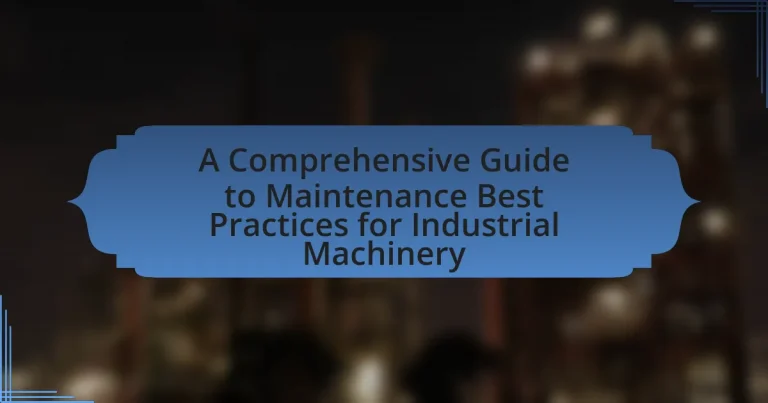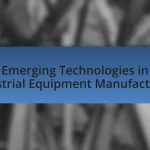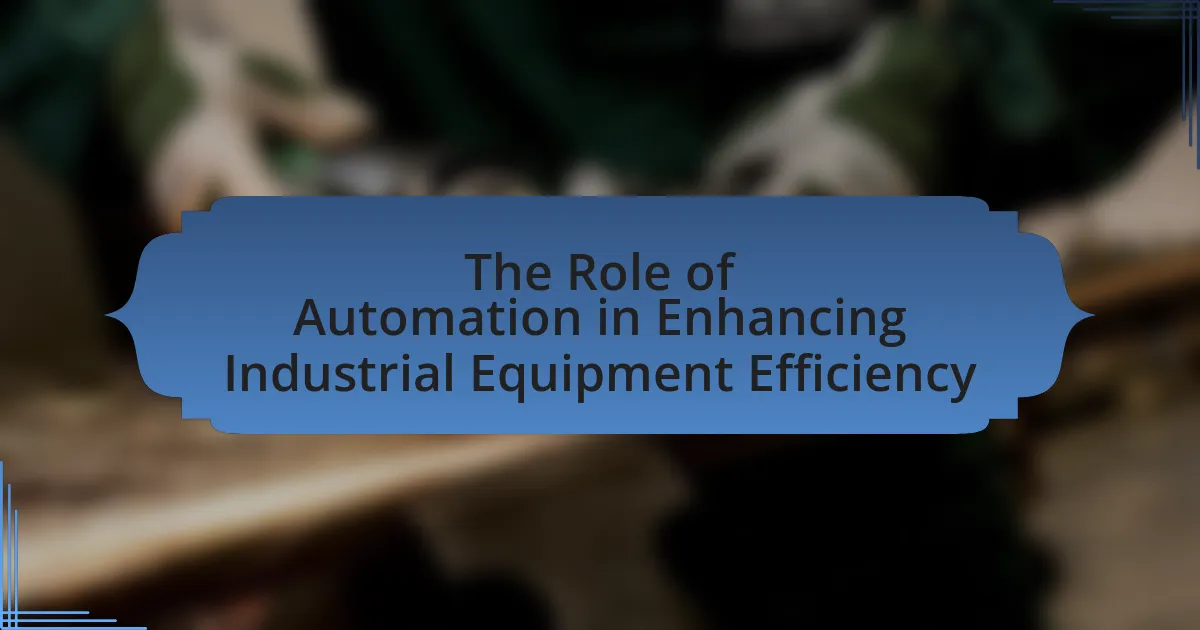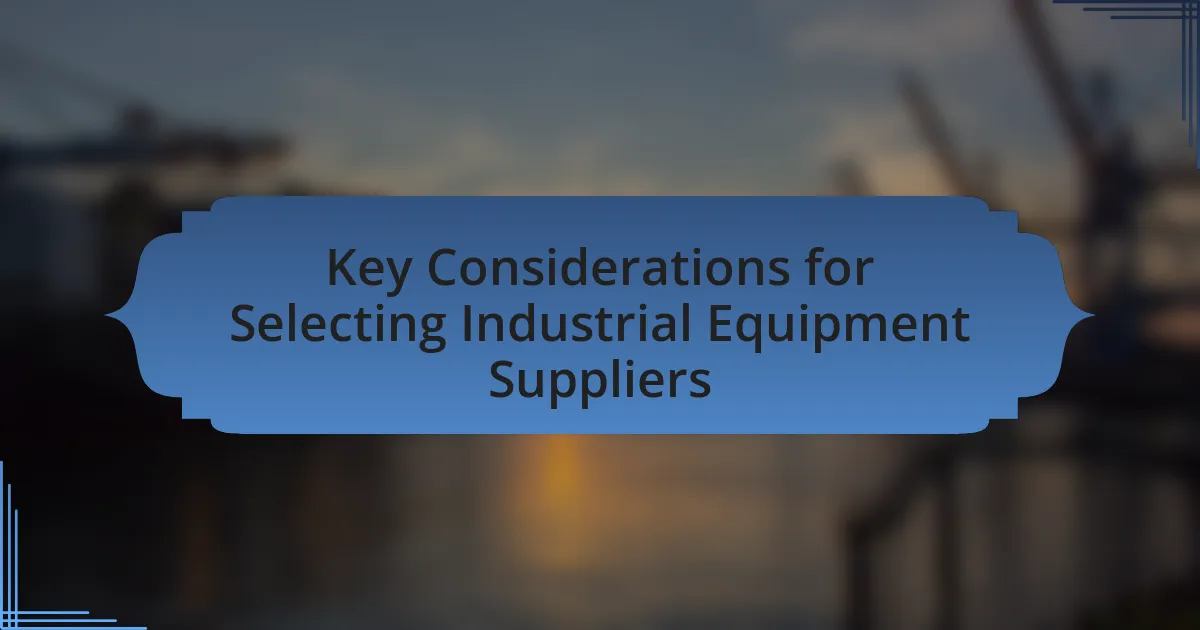The article provides a comprehensive guide to maintenance best practices for industrial machinery, emphasizing the importance of regular inspections, preventive maintenance, proper lubrication, and employee training. It outlines the critical role of maintenance in ensuring optimal performance and longevity of equipment, highlighting the consequences of neglecting maintenance, such as increased operational failures and safety risks. Various maintenance strategies, including preventive, predictive, and corrective maintenance, are discussed, along with the significance of documentation and structured maintenance programs. The article also addresses common challenges organizations face in implementing these practices and offers practical tips for effective machinery maintenance.
What are Maintenance Best Practices for Industrial Machinery?
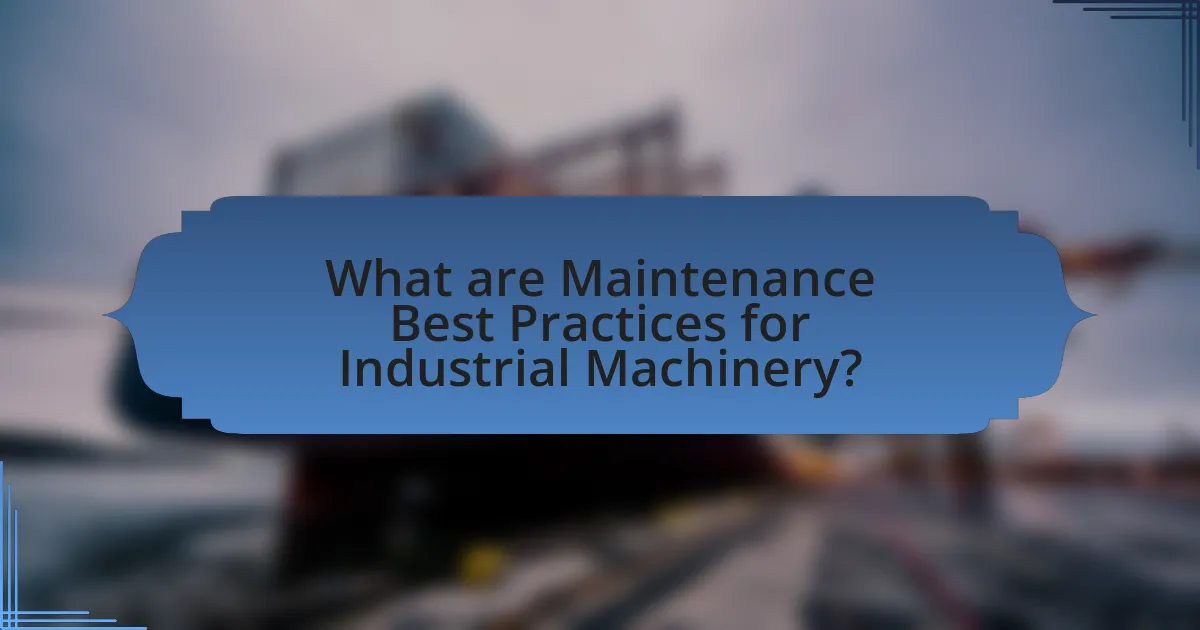
Maintenance best practices for industrial machinery include regular inspections, preventive maintenance, proper lubrication, and employee training. Regular inspections help identify potential issues before they escalate, while preventive maintenance schedules reduce unexpected breakdowns and extend equipment lifespan. Proper lubrication minimizes wear and tear on moving parts, ensuring efficient operation. Employee training enhances operational knowledge and safety, leading to better maintenance practices. According to the U.S. Department of Energy, implementing a preventive maintenance program can reduce maintenance costs by 25% to 30% and increase equipment reliability.
Why is maintenance critical for industrial machinery?
Maintenance is critical for industrial machinery because it ensures optimal performance and longevity of equipment. Regular maintenance reduces the risk of unexpected breakdowns, which can lead to costly downtime and repairs. According to a study by the U.S. Department of Energy, effective maintenance practices can improve equipment reliability by up to 30% and reduce maintenance costs by 25%. This highlights the importance of maintenance in enhancing operational efficiency and minimizing financial losses in industrial settings.
What are the consequences of neglecting maintenance?
Neglecting maintenance leads to increased operational failures and reduced equipment lifespan. When maintenance is overlooked, machinery is more prone to breakdowns, resulting in costly downtime and repairs. According to a study by the U.S. Department of Energy, poorly maintained equipment can consume up to 30% more energy, further escalating operational costs. Additionally, neglecting maintenance can compromise safety, leading to accidents that may result in injuries or fatalities. Regular maintenance is essential to ensure optimal performance, safety, and cost-effectiveness in industrial operations.
How does maintenance impact operational efficiency?
Maintenance significantly enhances operational efficiency by ensuring that machinery operates at optimal performance levels. Regular maintenance reduces the likelihood of unexpected breakdowns, which can lead to costly downtime. For instance, a study by the U.S. Department of Energy found that effective maintenance practices can improve equipment reliability by up to 30%, directly correlating with increased productivity and reduced operational costs. Additionally, well-maintained equipment consumes less energy, further contributing to overall efficiency.
What types of maintenance strategies exist?
There are several types of maintenance strategies that exist, including preventive maintenance, predictive maintenance, corrective maintenance, and condition-based maintenance. Preventive maintenance involves scheduled inspections and servicing to prevent equipment failures, while predictive maintenance uses data analysis and monitoring to predict when maintenance should be performed. Corrective maintenance is performed after a failure occurs to restore equipment to operational condition, and condition-based maintenance relies on real-time data to determine when maintenance is necessary. Each strategy aims to enhance equipment reliability and minimize downtime, contributing to overall operational efficiency in industrial settings.
What is the difference between preventive and corrective maintenance?
Preventive maintenance involves scheduled inspections and servicing to prevent equipment failures, while corrective maintenance is performed after a failure occurs to restore equipment to operational condition. Preventive maintenance aims to reduce the likelihood of unexpected breakdowns by addressing potential issues before they escalate, often based on manufacturer recommendations or historical performance data. In contrast, corrective maintenance is reactive, addressing problems only after they have manifested, which can lead to increased downtime and repair costs.
How does predictive maintenance enhance machinery longevity?
Predictive maintenance enhances machinery longevity by utilizing data analytics to anticipate equipment failures before they occur. This proactive approach allows for timely interventions, reducing unplanned downtime and extending the operational life of machinery. For instance, a study by the Aberdeen Group found that organizations implementing predictive maintenance experienced a 10% reduction in maintenance costs and a 20% increase in equipment uptime. By addressing potential issues early, predictive maintenance not only minimizes wear and tear but also optimizes maintenance schedules, ensuring that machinery operates efficiently over a longer period.
What are the key components of an effective maintenance program?
The key components of an effective maintenance program include preventive maintenance, predictive maintenance, corrective maintenance, and documentation. Preventive maintenance involves scheduled inspections and servicing to prevent equipment failures, which can reduce downtime by up to 30% according to industry studies. Predictive maintenance uses data analysis tools and techniques to predict when maintenance should be performed, thereby minimizing unexpected failures. Corrective maintenance addresses equipment failures after they occur, ensuring that machinery is restored to operational status promptly. Documentation is crucial as it provides a record of maintenance activities, helping to track performance and inform future maintenance strategies.
How do maintenance schedules contribute to machinery reliability?
Maintenance schedules enhance machinery reliability by ensuring regular inspections, servicing, and timely repairs. These schedules help identify potential issues before they escalate into major failures, thereby reducing downtime and extending the lifespan of equipment. For instance, a study by the U.S. Department of Energy found that implementing a structured maintenance schedule can improve equipment reliability by up to 30%, demonstrating the effectiveness of proactive maintenance in preventing unexpected breakdowns.
What role does documentation play in maintenance practices?
Documentation plays a critical role in maintenance practices by providing essential information that guides technicians in performing tasks accurately and efficiently. It serves as a reference for maintenance procedures, equipment specifications, and historical performance data, which helps in diagnosing issues and planning preventive maintenance. For instance, a study by the National Institute of Standards and Technology found that well-documented maintenance procedures can reduce equipment downtime by up to 30%, highlighting the importance of documentation in enhancing operational efficiency and reliability.
How can organizations implement maintenance best practices?

Organizations can implement maintenance best practices by establishing a structured maintenance program that includes regular inspections, preventive maintenance schedules, and employee training. A structured program ensures that machinery is routinely checked and serviced, which can reduce downtime and extend equipment lifespan. According to a study by the U.S. Department of Energy, implementing preventive maintenance can lead to a 10-20% reduction in maintenance costs and a 25-30% increase in equipment reliability. This evidence supports the effectiveness of a systematic approach to maintenance in industrial settings.
What steps should be taken to develop a maintenance plan?
To develop a maintenance plan, the following steps should be taken: assess the current condition of machinery, identify maintenance needs, establish maintenance objectives, create a schedule for maintenance activities, allocate resources, and implement monitoring and evaluation processes.
Assessing the current condition involves conducting inspections and reviewing historical performance data to understand the machinery’s status. Identifying maintenance needs requires determining which components require regular attention based on usage and manufacturer recommendations. Establishing maintenance objectives focuses on minimizing downtime and extending equipment lifespan. Creating a schedule ensures that maintenance tasks are performed consistently and timely. Allocating resources includes budgeting for parts, labor, and tools necessary for maintenance. Finally, implementing monitoring and evaluation processes allows for adjustments to the plan based on performance metrics and feedback, ensuring continuous improvement.
How do you assess the current state of machinery?
To assess the current state of machinery, conduct a thorough inspection that includes evaluating performance metrics, physical condition, and maintenance history. Performance metrics such as operational efficiency, downtime, and output quality provide quantitative data on machinery effectiveness. The physical condition assessment involves checking for wear, corrosion, and any signs of malfunction, which can be identified through visual inspections and diagnostic tools. Maintenance history, including records of repairs and scheduled maintenance, offers insights into potential issues and the reliability of the machinery. Regular assessments using these criteria can help identify necessary repairs or upgrades, ensuring optimal performance and longevity of industrial machinery.
What factors should be considered when prioritizing maintenance tasks?
When prioritizing maintenance tasks, factors such as equipment criticality, failure history, safety implications, and resource availability should be considered. Equipment criticality refers to how essential a machine is to operations; tasks related to high-criticality equipment should be prioritized to minimize downtime. Failure history provides insight into which machines are prone to breakdowns, allowing maintenance teams to focus on those with a history of frequent issues. Safety implications involve assessing the risks associated with equipment failure, where tasks that could lead to hazardous situations should be prioritized. Lastly, resource availability, including manpower and spare parts, influences the scheduling of maintenance tasks, ensuring that necessary resources are in place to perform the work efficiently.
How can technology improve maintenance practices?
Technology can improve maintenance practices by enabling predictive maintenance through data analytics and IoT sensors. These technologies allow for real-time monitoring of equipment conditions, which helps in identifying potential failures before they occur. For instance, a study by McKinsey & Company found that predictive maintenance can reduce maintenance costs by 10-40% and increase equipment uptime by 10-20%. By leveraging these advancements, organizations can optimize their maintenance schedules, reduce unplanned downtime, and enhance overall operational efficiency.
What are the benefits of using maintenance management software?
Maintenance management software enhances operational efficiency by streamlining maintenance processes, reducing downtime, and optimizing resource allocation. This software allows organizations to schedule preventive maintenance, track work orders, and manage inventory effectively. According to a study by the Aberdeen Group, companies using maintenance management software can achieve a 10-20% reduction in maintenance costs and a 25% increase in equipment uptime. These benefits lead to improved productivity and extended asset lifespan, making maintenance management software a crucial tool for industrial machinery management.
How can IoT devices assist in predictive maintenance?
IoT devices assist in predictive maintenance by continuously monitoring equipment conditions and performance metrics in real-time. These devices collect data such as temperature, vibration, and operational hours, which can be analyzed to identify patterns and predict potential failures before they occur. For instance, a study by McKinsey & Company found that predictive maintenance can reduce maintenance costs by 10-40% and increase equipment uptime by 10-20%. This data-driven approach enables organizations to schedule maintenance activities more effectively, minimizing unplanned downtime and optimizing resource allocation.
What are common challenges in maintaining industrial machinery?
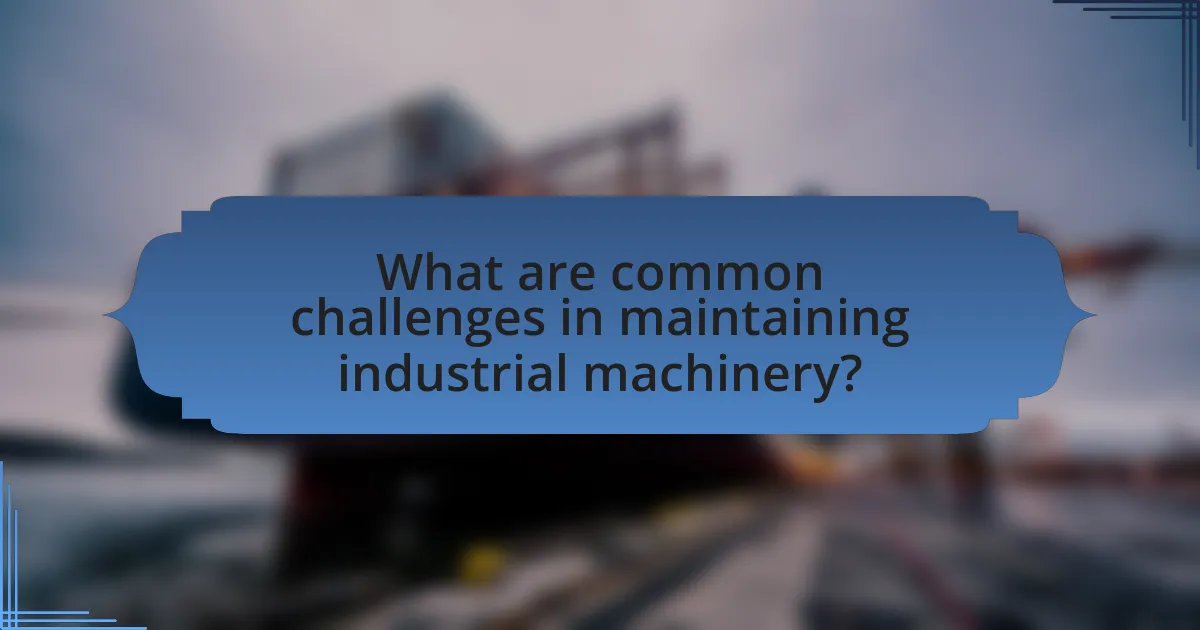
Common challenges in maintaining industrial machinery include equipment wear and tear, unexpected breakdowns, and the need for skilled labor. Equipment wear and tear occurs due to continuous operation, leading to decreased efficiency and increased maintenance costs. Unexpected breakdowns can disrupt production schedules and result in significant financial losses; for instance, a study by the U.S. Department of Energy found that unplanned downtime can cost manufacturers up to $260,000 per hour. Additionally, the shortage of skilled labor complicates maintenance efforts, as experienced technicians are essential for effective troubleshooting and repairs.
What obstacles do organizations face in implementing maintenance best practices?
Organizations face several obstacles in implementing maintenance best practices, including lack of skilled personnel, inadequate funding, and resistance to change. The shortage of trained maintenance staff can hinder the effective execution of best practices, as specialized knowledge is often required for advanced maintenance techniques. Additionally, insufficient budget allocations can limit the ability to invest in necessary tools, technologies, and training programs, which are essential for successful maintenance strategies. Resistance to change from employees and management can also impede the adoption of new practices, as established routines may be difficult to alter. These challenges collectively contribute to the difficulties organizations encounter in optimizing their maintenance operations.
How can budget constraints affect maintenance efforts?
Budget constraints can significantly limit maintenance efforts by reducing the availability of funds for necessary repairs and preventive measures. When financial resources are restricted, organizations may prioritize immediate operational needs over long-term maintenance, leading to deferred maintenance tasks. This can result in increased equipment downtime, higher repair costs, and ultimately, a decline in overall machinery performance. Studies have shown that companies that underinvest in maintenance can experience up to 20% more unplanned downtime, which directly impacts productivity and profitability.
What training is necessary for maintenance personnel?
Maintenance personnel require training in safety protocols, equipment operation, troubleshooting techniques, and preventive maintenance practices. This training ensures that personnel can effectively maintain industrial machinery while minimizing risks and maximizing efficiency. For instance, OSHA standards mandate safety training to prevent workplace accidents, while manufacturers often provide specific training on their equipment to ensure proper handling and maintenance. Additionally, understanding troubleshooting techniques is crucial, as studies show that effective problem-solving can reduce downtime by up to 30%.
How can organizations overcome these challenges?
Organizations can overcome challenges in maintenance best practices for industrial machinery by implementing a structured maintenance management system. This system should include regular training for staff on the latest maintenance techniques and technologies, which enhances their skills and knowledge, leading to improved machinery performance. Additionally, organizations can adopt predictive maintenance strategies that utilize data analytics to anticipate equipment failures before they occur, thereby reducing downtime and maintenance costs. According to a study by McKinsey & Company, predictive maintenance can reduce maintenance costs by 10-40% and increase equipment uptime by 10-20%. By integrating these practices, organizations can effectively address maintenance challenges and optimize their machinery operations.
What strategies can be employed to secure funding for maintenance?
To secure funding for maintenance, organizations can employ strategies such as developing a detailed maintenance plan, demonstrating the return on investment (ROI), and leveraging grants or partnerships. A comprehensive maintenance plan outlines specific needs, timelines, and costs, making it easier to justify funding requests. Demonstrating ROI involves presenting data that shows how regular maintenance reduces downtime and extends equipment life, which can be compelling for stakeholders. Additionally, seeking grants from government programs or forming partnerships with industry organizations can provide alternative funding sources. These strategies are supported by industry practices that emphasize proactive maintenance as a cost-saving measure, with studies indicating that every dollar spent on maintenance can save up to $4 in repairs and lost production.
How can continuous training improve maintenance outcomes?
Continuous training enhances maintenance outcomes by equipping personnel with updated skills and knowledge, leading to improved efficiency and reduced downtime. Regular training ensures that maintenance staff are familiar with the latest technologies, techniques, and safety protocols, which directly impacts their ability to perform tasks effectively. For instance, a study by the National Institute of Standards and Technology found that organizations that invest in continuous training can see a 20% increase in productivity and a significant decrease in equipment failure rates. This correlation demonstrates that ongoing education not only fosters a more competent workforce but also contributes to the overall reliability and longevity of industrial machinery.
What are practical tips for effective machinery maintenance?
Practical tips for effective machinery maintenance include establishing a regular maintenance schedule, conducting routine inspections, and ensuring proper lubrication of moving parts. Regular maintenance schedules help prevent unexpected breakdowns by addressing wear and tear before it leads to failure. Routine inspections allow for the early detection of potential issues, which can save time and costs associated with major repairs. Proper lubrication reduces friction and wear, extending the lifespan of machinery components. According to the U.S. Department of Energy, implementing a proactive maintenance strategy can reduce equipment downtime by up to 30%, highlighting the importance of these practices in maintaining operational efficiency.
How can regular inspections prevent major failures?
Regular inspections can prevent major failures by identifying potential issues before they escalate into significant problems. Through systematic evaluations, maintenance teams can detect wear and tear, misalignments, or other anomalies that could lead to equipment breakdowns. For instance, a study by the National Institute of Standards and Technology found that proactive maintenance, including regular inspections, can reduce equipment failure rates by up to 30%. This evidence underscores the importance of routine checks in maintaining operational efficiency and extending the lifespan of industrial machinery.
What are the best practices for documenting maintenance activities?
The best practices for documenting maintenance activities include maintaining detailed records, using standardized forms, and ensuring timely updates. Detailed records capture the specifics of each maintenance task, including date, time, personnel involved, and the nature of the work performed, which aids in tracking equipment history and performance. Standardized forms streamline the documentation process, making it easier to analyze data and identify trends over time. Timely updates ensure that all information is current, which is crucial for effective decision-making and compliance with regulatory requirements. These practices enhance accountability, improve communication among team members, and facilitate better planning for future maintenance needs.
